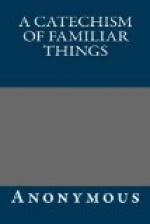When ripe, it is eaten by the natives either in its natural state, or bruised in wine. It is brought to us either candied or pickled, as the ripe fruit is very perishable; in the latter case, they are opened with a knife, and the middle filled up with fresh ginger, garlic, mustard, salt, and oil or vinegar. The fruit of the largest variety weighs two pounds or upwards. The several parts of this tree are all applied to some use by the Hindoos: the wood is consecrated to the service of the dead; from the flour of the dried kernels different kinds of food are prepared; the leaves, flowers, and bark, are medicinal.
Medicinal, fit for medicine, possessing medical properties.
Consecrated, separated from a common to a sacred use.
Is there not a tree which bears a fruit that may be used for bread?
Yes; the Bread-fruit Tree, originally found in the southeastern parts of Asia and the islands of the Pacific Ocean, though introduced into the tropical parts of America. It is one of the most interesting, as well as singular productions of the vegetable kingdom, being no less beautiful than it is useful. This tree is large and shady; its leaves are broad and indented, like those of the fig tree—from twelve to eighteen inches long, rather fleshy, and of a dark green. The fruit, when full-grown, is from six to nine inches round, and of an oval form—when ripe, of a rich, yellow tinge; it generally hangs in clusters of two or three, on a small thick stalk; the pulp is white, partly farinaceous, and partly fibrous, but when ripe, becomes yellow and juicy.
Indented, toothed like the edge of a saw.
Farinaceous,
mealy, consisting of meal or flour; from
farina, flour.
How is the Bread-Fruit eaten?
It is roasted until the outside is of a brown color and crisp; the pulp has then the consistency of bread, which the taste greatly resembles; and thus it forms a nourishing food: it is also prepared in many different ways, besides that just mentioned. The tree produces three, sometimes four crops in a year, and continues bearing for fifty years, so that two or three trees are enough for a man’s yearly supply. Its timber, which at first is of a rich yellow, but afterwards assumes the color of mahogany, is used in the building of houses and canoes; the flowers, when dried, serve as tinder; the sap or juice serves for glue; the inner bark is made, by the natives of some of the islands of the Pacific Ocean, into a kind of cloth; and the leaves are useful for many purposes. One species of the bread-fruit, called the Jaca tree, grows chiefly on the mainland of Asia.
Mainland, the continent.
Describe the Jaca Tree.
This kind grows to the same, if not a larger size than the bread-fruit of the islands, but is neither so palatable nor so nutritious; the fruit often weighs thirty pounds, and contains two or three hundred seeds, each four times as large as an almond. December is the time when the fruit ripens; it is then eaten, but not much relished; the seeds are also eaten when roasted. There are also other trees in different parts of the world, mostly of the palm species, which yield bread of a similar kind.




